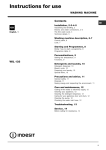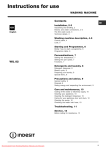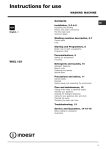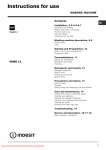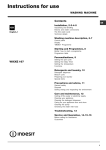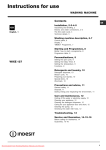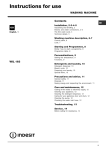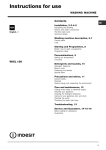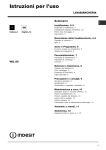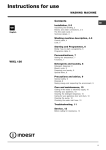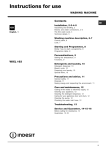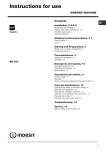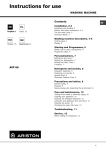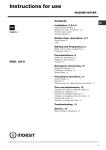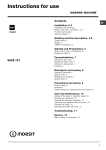Download Indesit WIL 153 Washer User Manual
Transcript
Instructions for use WASHING MACHINE Contents GB English, 1 GB Installation, 2-3-4-5 Unpacking and levelling, 2 Electric and water connections, 2-3 The first wash cycle, 4 Technical details, 5 Washing machine description, 6-7 Control panel, 6 Leds, 7 Starting and Programmes, 8 Briefly: how to start a programme, 8 Programme table, 8 Personalisations, 9 WIL 153 Setting the temperature, 9 Functions, 9 Detergents and laundry, 10 Detergent dispenser, 10 Bleach cycle, 10 Preparing your laundry, 10 Special items, 10 Precautions and advice, 11 General safety, 11 Disposal, 11 Saving energy and respecting the environment, 11 Care and maintenance, 12 Cutting off the water or electricity supply, 12 Cleaning your appliance, 12 Cleaning the detergent dispenser, 12 Caring for your appliance door and drum, 12 Cleaning the pump, 12 Checking the water inlet hose, 12 Troubleshooting, 13 Service, 14 Before calling for Assistance, 14 1 Installation Keep this instruction manual in a safe place for future reference. Should the appliance be sold, transferred or moved, make sure the instruction manual accompanies the washing machine to inform the new owner as to its operation and features. GB Read these instructions carefully: they contain vital information on installation, use and safety. Unpacking and levelling Unpacking 1. Unpack the washing machine. 2. Check whether the washing machine has been damaged during transport. If this is the case, do not install it and contact your retailer. 3. Remove the four protective screws and the rubber washer with the respective spacer, situated on the rear of the appliance (see figure). 4. Seal the gaps using the plastic plugs provided. 5. Use the plug provided to seal the three holes where the plug was housed, situated on the lower right-hand side on the rear of your appliance. 6. Keep all the parts: you will need them again if the washing machine needs to be moved to another location. Packaging materials are not children's toys. Levelling your appliance correctly will provide it with stability and avoid any vibrations, noise and shifting during operation. If it is placed on a fitted or loose carpet, adjust the feet in such a way as to allow enough room for ventilation beneath the washing machine. Electric and water connections Connecting the water inlet hose 1. Connect the supply pipe to the water mains using a gas 3/4 attachment, fitting the rubber gasket and the filter supplied with the appliance and ensuring that they are fimly tightened to the taps. The water supply marked C must be connected to the cold water tap; the pipe marked H must be connected to the hot water tap. Both pipes may be connected to the cold water tap using the special Y connection with multiple attachments, supplied with the appliance (see figure). Before making the connection, allow the water to run freely until it is perfectly clear. 2. Connect the other end of the water inlet hose to the washing machine, screwing it onto the appliance's cold water inlet, situated on the top right-hand side on the rear of the appliance (see figure). Levelling 1. Install the washing machine on a flat sturdy floor, without resting it up against walls, furniture cabinets or other. 2. If the floor is not perfectly level, compensate for any unevenness by tightening or loosening the adjustable front feet (see figure); the angle of inclination, measured according to the worktop, must not exceed 2°. 2 3. Make sure there are no kinks or bends in the hose. The water pressure at the tap must be within the values indicated in the Technical details table (on the next page). If the water inlet hose is not long enough, contact a specialist store or an authorised serviceman. Connecting the drain hose the socket is earthed and in compliance with the applicable law; the socket is compatible with the washing machine's plug. If this is not the case, replace the socket or the plug. Service As the colours of the wires in the lead may not correspond with the coloured markings identifyng the terminals in your plug, proceed as follows: Connect Green & Yellow wire to terminal marked E or coloured Green or Green & Yellow. or Connect Brown wire to terminal marked L or coloured Red. Connect Blue wire to terminal marked N or coloured Black. Troubleshooting the supply voltage is included within the values i ndicated on the Technical details table (see page 5); Instructions for connecting cable to an alternative plug: Important: the wires in the mains lead are coloured in accordance with the following code: Green & Yellow Earth Blue Neutral Brown Live Care the socket is able to sustain the appliance's maximum power load indicated in the Technical details table (see page 5); Disposing of the plug: Ensure that before disposing of the plug itself, you make the pins unusable so that it cannot be accidentally inserted into a socket. Precautions Before plugging the appliance into the mains socket, make sure that: Detergents Electric connection Removing the plug: If your appliance has a non-rewireable moulded plug and you should wish to re-route the mains cable through partitions, units etc., please ensure that either: the plug is replaced by a fused 13 ampere rewearable plug bearing the BSI mark of approval. or: the mains cable is wired directly into a 13 amp cable outlet, controlled by a switch, (in compliance with BS 5733) which is accessible without moving the appliance. Programmes We advise against the use of hose extensions; in case of absolute need, the extension must have the same diameter as the original hose and must not exceed 150 cm in length. Replacing the fuse: When replacing a faulty fuse, a 13 amp ASTA approved fuse to BS 1362 should always be used, and the fuse cover re-fitted. If the fuse cover is lost, the plug must not be used until a replacement is obtained. Replacement fuse covers: If a replacement fuse cover is fitted, it must be of the correct colour as indicated by the coloured marking or the colour that is embossed in words on the base of the plug. Replacements can be obtained directly from your nearest Service Depot. Description alternatively, place it over the edge of a basin, sink or tub, fastening the duct supplied to the tap (see figure). The free end of the hose should not be underwater. WARNING - THIS APPLIANCE MUST BE EARTHED. THE FOLLOWING OPERATIONS SHOULD BE CARRIED OUT BY A QUALIFIED ELECTRICIAN. GB Installation 65 - 100 cm Connect the drain hose, without bending it, to a draining duct or a wall drain situated between 65 and 100 cm from the floor; Your appliance is now supplied with a 13 amp fused plug it can be plugged into a 13 amp socket for immediate use. Before using the appliance please read the instructions below. 3 If a 13 amp plug (BS 1363) is used it must be fitted with a 13 amp fuse, either in the plug or adaptor or at the distribution board. If you are in any doubt the electrical supply to your machine, consult a qualified electrician before use. How to connect an alternative plug: The wires in this mains lead are coloured in accordance with the following code: BLUE NEUTRAL (N) BROWN LIVE (L) GREEN & YELLOW EARTH (E) GB Disposing of the appliance: When disposing of the appliance please remove the plug by cutting the mains cable as close as possible to the plug body and dispose of it as described above. GREEN & YELLOW BROWN BLUE 13 ampere fuse CROSS-BAR CORD GRIP The washing machine should not be installed in an outdoor environment, not even when the area is sheltered, because it may be very dangerous to leave it exposed to rain and thunderstorms. When the washing machine is installed, the mains socket must be within easy reach. Do not use extensions or multiple sockets. The power supply cable must never be bent or dangerously compressed. The power supply cable must only be replaced by an authorised serviceman. Warning! The company denies all liability if and when these norms are not respected. 4 The first wash cycle Once the appliance has been installed, and before you use it for the first time, run a wash cycle with detergent and no laundry, setting the 90°C programme without a pre-wash cycle. GB Technical details 59.5 cm wide 85 cm high 53.5 cm deep Capacity from 1 to 5 kg Electric connections voltage 230/240 Volts 50 Hz maximum absorbed power 2050 W Water connections maximum pressure 1 MPa (10 bar) minimum pressure 0.05 MPa (0.5 bar) drum capacity 46 litres Spin speed up to 1500 rpm Control programmes according to IEC456 directive programme 2; temperature 60°C; run with a load of 5 kg. Detergents This appliance is compliant with the following European Community Directives: - 73/23/CEE of 19/02/73 (Low Voltage) and subsequent amendments - 89/336/CEE of 03/05/89 (Electromagnetic Compatibility) and subsequent amendments Programmes Dimensions Description WIL 153 Installation Model Precautions Care Troubleshooting Service 5 Washing machine description Control panel GB FUNCTION Buttons Leds ON-OFF/ DOOR ON-OFF LOCK Button Led PROGRAMME Knob Detergent dispenser START/RESET Button TEMPERATURE Knob Detergent dispenser: to add detergent and fabric softener (see page 10). START/RESET button: to start the programmes or cancel any incorrect settings. LEDS: to find out which wash cycle phase is under way. If the Delay Timer function has been set, the time left until the programme starts will be indicated (see page 7). ON-OFF/DOOR LOCK Led: to find out whether the washing machine is on and if the appliance door can be opened (see page 7). FUNCTION buttons: to select the functions available. The button corresponding to the function selected will remain on. TEMPERATURE knob: to set the temperature or the cold wash cycle (see page 9). 6 ON/OFF button: to turn the washing machine on and off. PROGRAMME knob: to select the wash programmes. The knob stays still during the cycle. Leds Delay set: If the Delay Timer function has been enabled (see page. 9), once you have started the programme, the LED corresponding to the delay set will begin to flash: Prewash Wash Rinse Note: during draining, the LED corresponding to the Spin cycle phase will be turned on. Detergents Once the set delay is complete, the flashing LED will turn off and the programme set will start. Programmes As time passes, the remaining delay will be displayed, and the corresponding LED will flash: Function buttons The FUNCTION BUTTONS also act like LEDS. When a function is selected, the corresponding button is illuminated. If the function selected is incompatible with the programme set, the button will flash and the function will not be enabled. If you set a function that is incompatible with another function you selected previously, only the last one selected will be enabled. Description Spin cycle GB Installation The LEDS provide important information. This is what they can tell you: Cycle phase under way: During the wash cycle, the LEDs gradually illuminate on to indicate the cycle phase under way: Precautions Care Troubleshooting The rapid flashing of the ON-OFF/DOOR LOCK Led together with the flashing of at least one other LED indicates there is an abnormality. Call for Technical Assistance. Service ON-OFF/DOOR LOCK led: If this LED is on, the appliance door is locked to prevent it from being opened accidentally; to avoid any damages, wait for the LED to flash before you open the appliance door. 7 Starting and Programmes Briefly: starting a programme GB 6. Start he programme by pressing the START/RESET button. To cancel it, keep the START/RESET button pressed for at least 2 seconds. 7. When the programme is finished, the ON-OFF/ DOOR LOCK Led will flash to indicate that the appliance door can be opened. Take out your laundry and leave the appliance door ajar to allow the drum to dry thoroughly. Turn the washing . machine off by pressing button 1. Switch the washing machine on by pressing button . All the LEDS will light up for a few seconds and the ON-OFF/DOOR LOCK Led will begin to flash. 2. Load your laundry into the washing machine and shut the appliance door. 3. Set the PROGRAMME knob to the programme required. 4. Set the wash temperature (see page 9). 5. Add the detergent and any fabric softener (see page 10). Programme table Typ e of fab ric and d egree of soil P rogra m m es Tem p e rature D etergent Fabric softener prew as h w as h C ycle Stain rem oval length D escrip tion of wash cyc le op tion/b leach (m inutes) S tandard Extremely soiled whites (sheets, tablecloths, etc.) Extremely soiled whites (sheets, tablecloths, etc.) Heavily soiled whites and fast colours Heavily soiled whites and delicate colours Sligh tly soiled w hites an d delicate colou rs (sh irts, ju mpers, etc.) Heavily soiled fast colours (baby linen, etc.) Heavily soiled fast colours (baby linen, etc.) Delicate colours (all types of slightly soiled garments) Pre-wash, wash cycle, rinse cycles, intermediate and final spin cycles Wash cycle, rinse cycles, intermediate and final spin cycles Wash cycle, rinse cycles, intermediate and final spin cycles Wash cycle, rinse cycles, intermediate and final spin cycles 1 9 0°C 2 9 0°C 2 6 0°C 2 4 0°C 3 4 0°C D elicate/ Tradition al 70 4 5 0 °C D elicate 75 4 4 0°C D elicate 60 5 4 0°C D elicate 60 W oo l 6 4 0°C 50 Very delicate fabrics (cu rtain s, silk, viscose, etc.) 7 3 0°C 45 8 6 0°C 65 Wash cycle, rinse cycles, intermediate and final spin cycles 9 4 0°C 55 Wash cycle, rinse cycles, intermediate and final spin cycles 10 40 °C 45 11 3 0°C 30 Sports shoes (MAX. 2 pairs) 12 30 °C 50 Cold w ash (w ithout detergents), w ash cycle, rinse cycles, and delicate spin cycle Fabrics for sportswear (Tracksuits, shorts, etc.) 13 3 0°C 60 Wash cycle, rinse cycles, intermediate and final spin cycles 135 D elicate/ Tradition al D elicate/ Tradition al D elicate/ Tradition al 125 110 105 Wash cycle, rinse cycles, intermediate and final spin cycles Wash cycle, rin se cycles, an ticrease or delicate spin cycle Wash cycle, rin se cycles, an ticrease or delicate spin cycle Wash cycle, rin se cycles, an ticrease or delicate spin cycle W ash cycle, rin se cycles an ticrease or delicate spin cycle W ash cycle, rin se cycles , an ticrease o r drain in g cycle Tim e 4 yo u Heavily soiled whites and fast colours Sligh tly soiled w hites an d delicate colou rs (sh irts, ju mpers, etc.) Delicate colours (all types of slightly soiled garments) Delicate colours (all types of slightly soiled garments) Wash cycle, rin se cycles, delicate spin cycle W ash cycle, rin se cycles an d delicate spin cycle S po rt PAR TIAL P R OGR AM M E S R in se D elicate/ Tradition al R in se cycles an d spin cycle Spin cycle Draining and spin cycle D rain in g D rain in g Notes -For programmes 8 and 9, we advise against exceeding a wash load of 3.5 kg. -For programme 13 we advise against exceeding a wash load of 2 kg. -For the anti-crease function: see Easy iron, opposite page. The information contained in the table is purely indicative. Special programme Daily (programme 11 for Synthetics) is designed to wash lightly soiled garments in a short amount of time: it only lasts 30 minutes and allows you to save on both time and energy. By setting this programme (11 at 30°C), you can wash different fabrics together (except for woollen and silk items), with a maximum load of 3 kg. We recommend the use of liquid detergent. 8 Personalisations C Setting the temperature Turn the TEMPERATURE knob to set the wash temperature (see Programme table on page 8). The temperature can be lowered, or even set to a cold wash ( ). GB Installation Functions To enable a function: 1. press the button corresponding to the desired function, according to the table below; 2. the function is enabled when the corresponding button is illuminated. Function Easy iron Delays the start of the wash by up to 9 hours. Press the button repeatedly until the LED corresponding to the desired delay is turned on. The fifth time the button is pressed, the function will be disabled. N.B.: Once you have pressed the Start/Reset button, the delay can only be decreased if you wish to modify it. All Bleaching cycle designed to remove the toughest stains. Please remember to pour the bleach into extra compartment 4 (see page 10). This function is incompatible with the EASY IRON function. 2, 3, 4, 5, Rinse cycle. This option reduces the amount of creasing on fabrics, making them easier to iron. When this function is set, programmes 4, 5, 6, 7 will end with the laundry left to soak (Anti-crease) and the Rinse cycle phase LED will flash. - to conclude the cycle, press the START/RESET button; - to run the draining cycle alone, set the knob to the relative symbol and press the START/RESET button. This function is incompatible with the STAIN REMOVAL function. 3, 4, 5, 6, 7, 8, 9, 10, Rinse cycle. Increases the efficiency of the rinse. Recommended when the appliance has a full load or with large quantities of detergent. 1, 2, 3, 4, 5, 8, 9, 10, 12, 13, Rinse cycle. Precautions Extra Rinse Enabled with programmes: Detergents Stain removal Comments Programmes Delay Timer Effect Description Note: The rapid flashing of the button indicates that the corresponding function cannot be selected for the programme set. Care Troubleshooting Service 9 Detergents and laundry GB Detergent dispenser Preparing your laundry Good washing results also depend on the correct dose of detergent: adding too much detergent won't necessarily make for a more efficient wash, and may in fact cause build up on the interior of your appliance and even pollute the environment. Divide your laundry according to: - the type of fabric/the symbol on the label. - the colours: separate coloured garments from whites. Empty all pockets and check for loose buttons. Do not exceed the weight limits stated below, which refer to the weight when dry: Sturdy fabrics: max 5 kg Synthetic fabrics: max 2.5 kg Delicate fabrics: max 2 kg Wool: max 1 kg 4 1 2 3 Open up the detergent dispenser and pour in the detergent and fabric softener, as follows. How much does your laundry weigh? compartment 1: Detergent for pre-wash (powder) Before pouring in the detergent, make sure that extra compartment 4 has been removed. compartment 2: Detergent for the wash cycle (powder or liquid) Liquid detergent should only be poured in immediately prior to the wash cycle start. compartment 3: Additives (fabric softeners, etc.) The fabric softener should not overflow from the grid. extra compartment 4: Bleach Do not use hand wash detergent because it may form too much foam. Bleach cycle Traditional bleach should be used on sturdy white fabrics, and delicate bleach for coloured fabrics, synthetics and for wool. Place extra compartment 4, provided, into compartment 1. When pouring in the bleach, be careful not to exceed the "max" level indicated on the central pivot (see figure). To run the bleach cycle alone, pour the bleach into extra compartment 4 and set the Rinse programme . To bleach during a wash cycle, pour in the detergent and fabric softener, set the desired programme and enable the Stain removal option (see page 9). The use of extra compartment 4 excludes the possibility of using the pre-wash cycle. 10 1 1 1 1 1 sheet 400-500 g pillow case 150-200 g tablecloth 400-500 g bathrobe 900-1,200 g towel 150-250 g Special items Curtains: fold curtains and place them in a pillow case or mesh bag. Wash them separately without exceeding half the appliance load. Use programme 7 which excludes the spin cycle automatically. Quilted coats and windbreakers: if they are padded with goose or duck down, they can be machine-washed. Turn the garments inside out and load a maximum of 2-3 kg, repeating the rinse cycle once or twice and using the delicate spin cycle. Wool: for best results, use a specific detergent, taking care not to exceed a load of 1 kg. Precautions and advice General safety This appliance has been designed for nonprofessional, household use and its functions must not be changed. Do not pull on the power supply cable to unplug the appliance from the electricity socket. Pull the plug out yourself. Do not touch the drain water as it could reach very high temperatures. In the event of a malfunction, do not under any circumstances touch internal parts in order to attempt repairs. Always keep children well away from the appliance while in operation. Before loading your laundry into the washing machine, make sure the drum is empty. Disposal Use the correct quantity of detergent depending on the water hardness, how soiled the garments are and the amount of laundry you have, to avoid wastage and to protect the environment: despite being biodegradable, detergents do contain ingredients that alter the natural balance of the environment. In addition, avoid using fabric softener as much as possible. If you use your washing machine from late in the afternoon until the early hours of the morning, you will help reduce the electricity board's peak load. The Delay Timer option (see page 9) helps to organise your wash cycles accordingly. If your laundry has to be dried in a tumble dryer, select a high spin speed. Having the least water possible in your laundry will save you time and energy in the drying process. Service Disposing of the packaging material: observe local regulations, so the packaging can be re-used. Treating stains with a stain remover or leaving them to soak before washing will cut down the need to wash them at high temperatures. A programme at 60°C instead of 90°C or one at 40°C instead of 60°C will save up to 50% on energy. Troubleshooting Should it have to be moved, proceed with the help of two or three people and handle it with the utmost care. Never try to do this alone, because the appliance is very heavy. The pre-wash cycle is only necessary on extremely soiled garments. Avoiding it will save on detergent, time, water and between 5 and 15% energy. Care The appliance door tends to get quite hot during the wash cycle. Saving on detergent, water, energy and time To avoid wasting resources, the washing machine should be used with a full load. A full load instead of two half loads allows you to save up to 50% on energy. Precautions Never force the washing machine door: this could damage the safety lock mechanism designed to prevent any accidental openings. Environmentally-friendly technology If you only see a little water through your appliance door, this is because thanks to the latest Ariston technology, your washing machine only needs less than half the amount of water to get the best results: an objective reached to respect the environment. Detergents Do not open the detergent dispenser while the appliance is in operation. Saving energy and respecting the environment Programmes Never touch the washing machine when barefoot or with wet or damp hands or feet. GB Description This washing machine should only be used by adults and in accordance with the instructions provided in this manual. Disposing of an old washing machine: before scrapping your appliance, cut the power supply cable and remove the appliance door. Installation The washing machine was designed and built in compliance with the applicable international safety regulations. The following information is provided for your safety and should consequently be read carefully. 11 Care and maintenance Cutting off the water or electricity supply GB Turn off the water tap after every wash. This will limit the wear of your appliance's water system and also prevent leaks. Unplug your appliance when cleaning it and during all maintenance operations. Cleaning your appliance The exterior and rubber parts of your appliance can be cleaned with a soft cloth soaked in lukewarm soapy water. Do not use solvents or abrasives. Cleaning the detergent dispenser Remove the dispenser by raising it and pulling it out (see figure). Wash it under running water; this operation should be repeated frequently. Cleaning the pump The washing machine is fitted with a self-cleaning pump that does not require any maintenance. Sometimes, small items (such as coins or buttons) may fall into the pre-chamber that protects the pump, situated in the lower part of the same. Make sure the wash cycle has ended and unplug the appliance. To access the pre-chamber: 1. using a screwdriver, remove the cover panel on the lower front of the washing machine (see figure); 2. unscrew the lid rotating it anticlockwise (see figure): a little water may trickle out. This is perfectly normal; Caring for your appliance door and drum Always leave the appliance door ajar to prevent unpleasant odours from forming. 3. clean the interior thoroughly; 4. screw the lid back on; 5. reposition the panel, making sure the hooks are securely in place before you push it onto the appliance. Checking the water inlet hose Check the water inlet hose at least once a year. If you see any cracks, replace it immediately: during the wash cycles, water pressure is very strong and a cracked hose could easily split open. Never use hoses that have already been used. 12 Troubleshooting Your washing machine could fail to work. Before calling for Assistance (see page 14), make sure the problem can't easily be solved by consulting the following list. The water inlet hose is not connected to the tap. The hose is bent. The water tap is not turned on. There is a water shortage. The water pressure is insufficient. The START/RESET button has not been pressed. The washing machine continuously loads and unloads water. The drain hose is not fitted between 65 and 100 cm from the floor (see page 3). The free end of the hose is underwater (see page 3). The wall drainage system doesn't have a breather pipe. If the problem persists even after these checks, turn off the water tap, switch the appliance off and call for Assistance. If the dwelling is on one of the upper floors of a building, there may be drain trap problems causing the washing machine to load and unload water continuously. In order to avoid such an inconvenience, special anti-drain trap valves are available in shops. The washing machine does not drain or spin. The programme does not foresee the draining: some programmes require enabling the draining manually (see page 8). The Easy iron option is enabled: to complete the programme, press the START/RESET button (see page 9). The drain hose is bent (see page 3). The drain duct is clogged. The washing machine vibrates too much during the spin cycle. The drum was not unblocked correctly during installation (see page 2). The washing machine is not level (see page 2). The washing machine is closed in between furniture cabinets and the wall (see page 2). The washing machine leaks. The water inlet hose is not screwed on correctly (see page 2). The detergent dispenser is obstructed (to clean it, see page 12). The drain hose is not secured properly (see page 3). The ON-OFF/DOOR LOCK Led flashes rapidly at the same time as at least one other LED. Call for Assistance because this means there is an abnormality. There is too much foam. The detergent is not suitable for machine washing (it should bear the definition "for washing machines" or "hand and machine wash", or the like). You used too much detergent. Service The washing machine fails to load water. Troubleshooting The appliance door is not shut properly. button has not been pressed. The The START/RESET button has not been pressed. The water tap is not turned on. A delayed start has been set (using the Delay Timer, see page 9). Care Precautions The wash cycle won't start. Detergents The appliance is not plugged into the socket, or not enough to make contact. There has been a power failure. Programmes The washing machine won't start. Description Possible causes/Solution: Installation Problem GB 13 Service Before calling for Assistance: Check whether you can solve the problem on your own (see page 13); Restart the programme to check whether the problem has been solved; If this is not the case, contact an authorised Technical Service Centre on the telephone number provided on the guarantee certificate. GB Always request the assistance of authorised servicemen. Notify the operator of: the type of problem; the appliance model (Mod.); the serial number (S/N). This information can be found on the data plate situated on the rear of the washing machine. 14 GB Installation Description Programmes Detergents Precautions Care Troubleshooting Service 15 195039812.02 01/2004 - Xerox Business Services GB 16
















